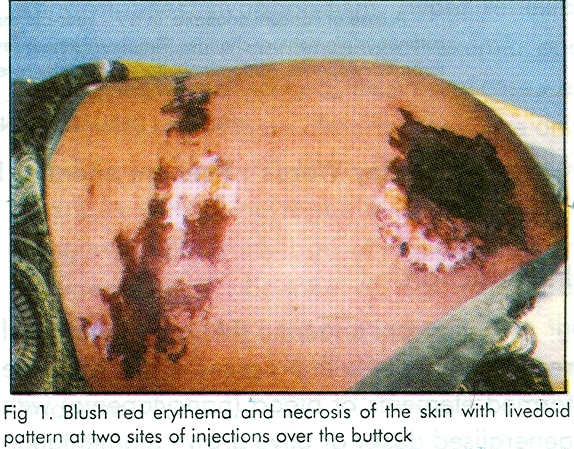Translate this page into:
Nicolau syndrome
Correspondence Address:
D Masthan Saheb
Department of Dermatology, Government General Hospital Kurnool-518 002, Andhra Pradesh
India
| How to cite this article: Masthan Saheb D, S, M, Reddy K C, S, L, R, P, K, A. Nicolau syndrome. Indian J Dermatol Venereol Leprol 2002;68:45-46 |
Abstract
A case of Nicolau syndrome in a woman following intramuscular injection of diclofenac sodium is reported. |
 |
Introduction
Nicolau syndrome (NS) also called embolia cutis medicamentosa, is a rare entity that consists of necrosis of the skin with livedoid pattern following injections of phenylbutazones, corticosteroids, local anaesthetics and antibiotics.[1] It was first described by Nicolau in 1925 following the use of bismuth salts for the treatment of syphilis.[1] It is due to intramural or periarterial injection of the offending drug with subsequent arterial spasm and cutaneous necrosis.[1] While the injection is being administered there is burning and stabbing pain. The first visible sign is pallor, followed by bluishred, net-like erythema. With in a few days the area becomes haemorragic and forms a necrotic eschar. Eventually the ulcer heals leaving behind an atrophic scar. We report one such case.
Case Report
A-28-year-old postnatal female patient attended the department of Dermatology with bluish discolouration in the left gluteal region since 2 days. She had an injection of diclofenac sodium in the left gluteal region after delivery along with oral antibiotics. She experienced severe burning pain while the injection was being administered. On the next day she noticed bluish discolouration of the skin and on the fifth day it became necrotic eschar. Routine haematological investigations including bleeding time, clotting time and platelet counts were within normal limits. The diagnosis of NS was made and the patient was referred to surgeon who removed the eschar and it healed with an atrophic scar. [Figure - 1]
Discussion
Nicolau syndrome, consisting of necrosis of the skin with livedoid pattern usually follows the injections of phenylbutazone, corticosteroids, local anaesthetics, antibiotics, antirheumatic drugs and antihistamines.[1] More rarely chlorpromazine, phenobarbitone and sulphonamides have been implicated.[2] It is very rare complication of intramuscular injections.
It is an end result of intramural or periarterial injection of the offending drug with subsequent arterial vasospasm and cutaneous necrosis.[1] Stefan, et al reported a case of NS following intra-articular injection into the knee.[3]
Rasokath reported a case of NS after subcutaneous injection of alpha interferon in two patients of HIV associated disseminated Kaposis′ sarcoma.[4]
We are reporting one such case for the first time in the Indian Journal following intramuscular injection of diclofenac sodium.
For prevention the site of injection has to be the ventrolateral or lateral aspect of the thigh.[1]
| 1. |
Uday P Khopkar. Nicolau syndrome in: What is new in Dermatology, Sexually Transmitted Diseases and Leprosy, Edited by Valia RG, Bombay, 2000;22:30
[Google Scholar]
|
| 2. |
Brethnach SM. Drug reactions, In: Textbook of Dermatology. Edited by Champion RH, Burton JL, Burns DA, Brethnach SM, 6th Edition, London. Blackwell Science Ltd. 1998; 3497.
[Google Scholar]
|
| 3. |
Stefan Deissert. Embolia cuits medicamentosa (Nicolau syndrome). Nach intra aricurarer injektion, Hautarzt 1999;50:214-216.
[Google Scholar]
|
| 4. |
Rasokar H. Aseptic necrosis after subcutaneous injection of alfa interferon. Disch med wochenschr 1989;114:45:458-460.
[Google Scholar]
|





